Witold Pilecki
| Witold Pilecki | |
|---|---|
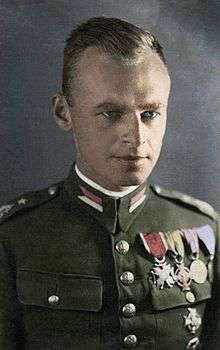 Pilecki in a colorized pre-1939 photo | |
| Born |
13 May 1901 Olonets, Olonets Governorate (Karelia). Russian Empire |
| Died |
25 May 1948 (aged 47) Mokotów Prison, Warsaw. People's Republic of Poland |
| Buried | Unknown; possibly in Powązki Cemetery |
| Allegiance | Second Polish Republic; Polish Government in Exile |
| Years of service | 1918–1947 |
| Rank | Captain, Cavalry master |
| Commands held |
|
| Battles/wars |
|
| Awards | |
Witold Pilecki (13 May 1901 – 25 May 1948; Polish pronunciation: [ˈvitɔlt piˈlɛt͡skʲi]; codenames Roman Jezierski, Tomasz Serafiński, Druh, Witold) was a Polish cavalry officer, intelligence agent, and resistance leader. He served as a Rotmistrz (captain) with the Polish Army in the Polish-Soviet War, Second Polish Republic, and World War II. He was also a co-founder of the Secret Polish Army (Tajna Armia Polska), a resistance group in German-occupied Poland, and later a member of the underground Home Army (Armia Krajowa). He was the author of Witold's Report, the first comprehensive Allied intelligence report on Auschwitz concentration camp and the Holocaust.[1]
During World War II, Pilecki volunteered for a Polish resistance operation that involved being imprisoned in the Auschwitz death camp in order to gather intelligence and later escape. While in the camp, he organized a resistance movement and informed the Western Allies of Nazi Germany's Auschwitz atrocities as early as 1941.[2] He escaped from the camp in 1943 after nearly 2½ years of imprisonment.[3] He took part as a combatant in the Warsaw Uprising[4] in August–October 1944.[5] He remained loyal to the London-based Polish government-in-exile after the Communist takeover of Poland, and he was arrested for espionage in 1947 by the Stalinist secret police (Urząd Bezpieczeństwa) on charges of working for "foreign imperialism", a euphemism for British Intelligence.[6][7] He was executed after a show trial in 1948. Information was suppressed about his exploits and fate until 1989 by the Communist regime in Poland.[7][8]
Pilecki is considered as "one of the greatest wartime heroes" because of his efforts.[5][9][10] Poland's Chief Rabbi Michael Schudrich writes in The Auschwitz Volunteer: Beyond Bravery:[11] "When God created the human being, God had in mind that we should all be like Captain Witold Pilecki, of blessed memory."[12] British historian Norman Davies writes: "If there was an Allied hero who deserved to be remembered and celebrated, this was a person with few peers."[12] Polish ambassador Ryszard Schnepf described Pilecki as a "diamond among Poland's heroes" and "the highest example of Polish patriotism" at the commemoration event of International Holocaust Remembrance Day held in the US Holocaust Memorial Museum on 27 January 2013.[10][13]
Life
Witold Pilecki was born on 13 May 1901 in the town of Olonets, Karelia, in the Russian Empire. He was a descendant of an aristocratic family (szlachta) originally from the Grodno Region. His grandfather, Józef Pilecki h. Leliwa, was a member of the Polish landed gentry and a dedicated Polish nationalist. He had been a supporter of the secessionist January Uprising of 1863–1864. Following the brutal defeat of the uprising by Russian forces, Józef Pilecki, like most Polish nobles who supported the rebellion, had his title revoked; his estate near Lida and his other properties were confiscated by the Russian government. He was also condemned to exile in Siberia for seven years. After his release he and his family were forcibly resettled by Tsarist authorities to the remote territory of Karelia. The family was prohibited from living outside this province for the next 30 years and its members were bound by law to be employed only by the Russian state.[14]
Witold's father, Julian Pilecki, was trained as a forester in Saint Petersburg and joined the Russian civil service, taking a position as a senior inspector with the Board of National Forests in Karelia. He would eventually settle in the town of Olonets where he married Ludwika Pilecki née Osiecimska. Witold Pilecki was the fourth of the couple's five children. In 1910, Ludwika and the children left Karelia and relocated to the Northwestern Krai. After being joined by their father the family settled in Wilno (now: Vilnius, Lithuania), where Pilecki completed primary school and became a member of the secret ZHP Scouts organization.[14] During the First World War, Wilno was occupied by the German Army on 5 September 1915 and was incorporated into Ober Ost, the German military administration. Pilecki and his family fled to Mogilev, Byelorussia. In 1916 Pilecki moved to the Russian city of Oryol, where he attended gymnasium and founded a local chapter of the ZHP group.[14]
Polish–Soviet War and later career
In 1918, following the outbreak of the Russian Revolution and the defeat of the Central Powers in World War I, Pilecki returned to Wilno (now part of the newly independent Polish Second Republic) and joined a ZHP Scout section of the Lithuanian and Belarusian Self-Defense Militia, a paramilitary formation aligned with the White movement under General Władysław Wejtko.[14] The militia disarmed the retreating German troops and took up positions to defend the city from a looming attack by the Soviet Red Army. However, Wilno fell to Bolshevik forces on 5 January 1919, and Pilecki and his unit resorted to partisan warfare behind Soviet lines. He and his comrades then retreated to Białystok where Pilecki enlisted as a szeregowy (private) in Poland's newly-established volunteer army. He took part in the Polish-Soviet War of 1919–1921, serving under Captain Jerzy Dąbrowski.[14] He fought in the Kiev Offensive (1920) and as part of a cavalry unit defending the city of Grodno. On 5 August 1920, Pilecki joined the 211th Uhlan Regiment and fought in the crucial Battle of Warsaw and in the Rudniki Forest (Puszcza Rudnicka). Pilecki later took part in the liberation of Wilno and briefly served in the ongoing Polish-Lithuanian War as a member of the October 1920 Żeligowski rebellion.[14] He was twice awarded the Krzyż Walecznych (Cross of Valor) for gallantry.[15]
Following the conclusion of Polish-Soviet War in March 1921 Pilecki was transferred to the army reserves. He was promoted to the rank of plutonowy (corporal) and was designated as a non-commissioned officer. He went on to complete his secondary education (matura) later that same year. In 1922 Pilecki briefly attended the University of Poznań where he studied agriculture. He soon returned to Wilno and enrolled with the Faculty of Fine Arts at Stefan Batory University. Pilecki was forced to abandon his studies in 1924 due to both financial issues and the declining health of his father.[14] He remained active in the military as a member of the army reserves and served as a military instructor in Nowe Święcice. Pilecki later underwent officer-training at the Cavalry Reserve Officers' Training School in Grudziądz.[14] Following his graduation Pilecki was assigned to the 26th Lancer Regiment in July 1925 with the rank of Chorąży (ensign). Pilecki would be promoted to Podporucznik (second lieutenant) the following year.[14]
In September 1926 Pilecki became the owner of his family's ancestral estate, Sukurcze, in the Lida district of the Nowogródek Voivodeship. Pilecki rebuilt and modernized the property's manor house, which had been destroyed during World War I. On 7 April 1931, he married Maria Pilecka née Ostrowska (1906 – 6 February 2002), a local school teacher originally from Kupa (Narach, currently Belarus). They had two children, born in Wilno: Andrzej (16 January 1932) and Zofia (14 March 1933). Pilecki and his family would later take up residence at Sukurcze. Pilecki developed a reputation as a community leader, a prominent social worker and amateur painter. He was also a vigorous advocate of rural development, founding an agricultural cooperative, heading the local fire brigade and also serving as chairman of a local milk-processing plant built in the district.[14] In 1932 Pilecki established a cavalry training school in Lida. Shortly afterward he was appointed commander of the newly-established 1st Lidsky Squadron, a position he would hold until 1937, when this unit was absorbed into the Polish 19th Infantry Division. In 1938, Pilecki received the Silver Cross of Merit for his community activism and his social work.[14]
World War II
| Part of a series on the |
Underground State |
|---|
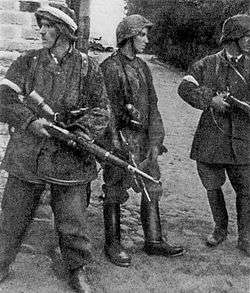 |
|
Authorities |
|
Political organizations |
|
Military organizations |
|
Related topics |
Pilecki was mobilized as a cavalry platoon commander on 26 August 1939. He was assigned to the 19th Infantry Division under General Józef Kwaciszewski, part of the Polish Army Prusy,[14] and his unit took part in heavy fighting against the advancing Germans during the invasion of Poland. The platoon was almost completely destroyed following a clash with the German forces on 10 September,[14] and it withdrew to the southeast toward Lwów (now L'viv in Ukraine) and the Romanian bridgehead. It was incorporated into the 41st Infantry Division, in which Pilecki served as divisional second-in-command under Major Jan Włodarkiewicz.[14] He and his men destroyed seven German tanks, shot down one aircraft, and destroyed two more on the ground.[16][17]
On 17 September, the Soviet Union invaded eastern Poland following the Molotov-Ribbentrop Pact. The Polish government formally surrendered to Nazi Germany on 27 September 1939, but Pilecki and many of his men continued fighting as partisans. His division was disbanded on 17 October, with parts of it surrendering to the enemy.[14] Pilecki went into hiding in Warsaw with his commander Major Włodarkiewicz.[14] On 9 November 1939, the two men founded the Secret Polish Army (Tajna Armia Polska, TAP), one of the first underground organizations in Poland.[14][18] Pilecki became organizational commander of TAP as it expanded to cover Warsaw, Siedlce, Radom, Lublin, and other major cities of central Poland.[14]
By 1940, TAP had approximately 8,000 men, 20 machine guns, and several anti-tank rifles. To maintain his cover, Pilecki worked as a manager of a cosmetics storehouse. Later, TAP was incorporated into the Union for Armed Struggle (Związek Walki Zbrojnej), later renamed the Home Army (Armia Krajowa, AK).[14][19] Within the AK, TAP elements became the core of the Wachlarz unit.[15]
Auschwitz
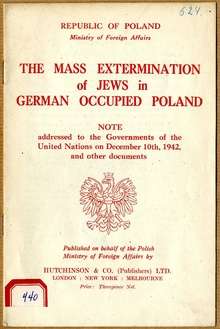
In 1940, Pilecki presented a plan to his superiors to enter Germany's Auschwitz concentration camp at Oświęcim to gather intelligence on the camp from the inside and organize inmate resistance.[18] Little was known about how the Germans ran the camp, and it was thought to be an internment camp or large prison rather than a death camp. His superiors approved the plan and provided him with a false identity card in the name of "Tomasz Serafiński".[20] He went out during a Warsaw street roundup on 19 September 1940 and was caught by the Germans along with 2,000 civilians, including Wladyslaw Bartoszewski.[20] He was detained for two days in the Light Horse Guards Barracks, where prisoners suffered beatings with rubber truncheons,[21] then sent to Auschwitz where he was assigned inmate number 4859.[20] During his imprisonment, Pilecki was promoted by the Home Army to the rank of Porucznik (first lieutenant).[14]
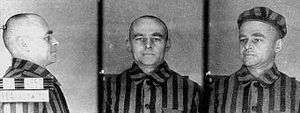
Pilecki organized the underground Union of Military Organizations (ZOW) at Auschwitz while working in various kommandos and surviving pneumonia.[14][22] Many smaller underground organizations at Auschwitz eventually merged with ZOW.[14][23] ZOW's tasks were to improve inmate morale, provide news from outside, distribute extra food and clothing to members, set up intelligence networks, and train detachments to take over the camp in the event of a relief attack by the Home Army, arms airdrops, or an airborne landing by the Polish 1st Independent Parachute Brigade based in Britain.[14][22]
ZOW provided the Polish underground with invaluable information about the camp;[22] they sent reports to Warsaw from October 1940,[24] and the reports were forwarded via the Polish resistance to the British government in London beginning in March 1941.[25] In 1942, Pilecki's resistance movement was also broadcasting details on the number of arrivals and deaths in the camp and the inmates' conditions using a radio transmitter that was built by camp inmates. The secret radio station was built over seven months using smuggled parts; it was broadcasting from the camp until the autumn of 1942, when it was dismantled by Pilecki's men after concerns that the Germans might discover its location because of "one of our fellow's big mouth".[21]
These reports were a principal source of intelligence on Auschwitz for the Western Allies. Pilecki hoped that either the Allies would drop arms or troops into the camp, or that the Home Army would organize an assault on it from outside.[14][23] Meanwhile, the Camp Gestapo under SS-Untersturmfuhrer Maximilian Grabner redoubled its efforts to ferret out ZOW members, killing many of them.[14][26] Pilecki decided to break out of the camp with the hope of convincing Home Army leaders personally that a rescue attempt was a valid option. He was assigned to a night shift at a camp bakery outside the fence, and he and two comrades overpowered a guard, cut the phone line, and escaped on the night of 26/27 April 1943, taking with them documents stolen from the Germans.[27]
Outside the camp
After several days as a fugitive Pilecki made contact with units of the Home Army.[14][23] On 25 August 1943, Pilecki reached Warsaw and was attached to Section II (intelligence and counter-intelligence) of the Home Army's regional headquarters. After losing several operatives reconnoitering the vicinity of Auschwitz, including the Cichociemny Stefan Jasieński, it was decided that the Home Army lacked sufficient strength to liberate the camp without Allied help.[22] Pilecki's detailed report (Raport Witolda – Witold's Report) estimated that "By March 1943 the number of people gassed on arrival reached 1.5 million", which was remarkably accurate considering post-war estimates suggest 1.1 million people died in Auschwitz during the war.[28]
On 11 November 1943, Pilecki was promoted to Rotmistrz (cavalry captain) and joined a secret anti-communist organization, NIE (in Polish: "NO or NIEpodległość – INdependence"), formed as a clandestine unit within the Home Army with the goal of preparing resistance against a possible Soviet occupation.[14] The Soviet Red Army, despite being within attacking distance of the camp, showed no interest in a joint effort with the Home Army and the ZOW to free it.[29] Until he became involved in the Warsaw Uprising, Pilecki remained in charge of coordinating ZOW and AK activities and provided what limited support he was able to offer to ZOW.[14]
Warsaw Uprising
When the Warsaw Uprising broke out on 1 August 1944, Pilecki volunteered for service with Kedyw's Chrobry II Battalion. At first, Pilecki served as a common soldier in the northern city center, without revealing his actual rank to his superiors.[14] Later, after many officers were killed in the fierce fighting that occurred during the early days of the uprising, Pilecki disclosed his true identity to his superiors and accepted command of the 1st "Warszawianka" Company located in Śródmieście in downtown Warsaw. Pilecki fought under the nom de guerre "Captain Roman".[14]
After the capitulation of the uprising, Pilecki hid a cache of weapons in a private apartment and surrendered to the Wehrmacht on 5 October 1944. He was imprisoned at Stalag VIII-B, a German prisoner-of-war camp near Lamsdorf, Silesia. He was later transferred to Oflag VII-A in Murnau, Bavaria where he was liberated by troops of the US 12th Armored Division on 28 April 1945.[14]
Communist Poland

In July 1945 he left Murnau and was reassigned to the military intelligence division of the Polish II Corps under General Władysław Anders in Ancona, Italy. While stationed there Pilecki began writing a monograph on his experiences at Auschwitz.[14]
In October 1945, as relations between the Polish government-in-exile and the Soviet-backed regime of Boleslaw Bierut deteriorated, Pilecki was ordered by General Anders and his intelligence chief, Lt. Colonel Stanislaw Kijak, to return to Poland and report on the prevailing military and political situation under Soviet-occupation.[14][23]
Pilecki arrived in Warsaw in December 1945 and proceeded to begin organizing an intelligence gathering network, which included several wartime associates from Auschwitz and the Secret Polish Army (TAP).[7][14]
To maintain his cover identity, Pilecki lived under various assumed names and changed jobs frequently. He would work as a jewelry salesman, a bottle label painter and as night manager of a construction warehouse. Nevertheless, Pilecki was informed in July 1946 that his actual identity had been uncovered by the MBP. He was ordered to leave the country, but he refused to do so.[14]
In April 1947, he began independently collecting evidence of Soviet atrocities committed in Poland during the 1939–1941 occupation as well as evidence of the unlawful arrest and prosecution of Home Army veterans and ex-members of the Polish Armed Forces in the West, which often resulted in execution or imprisonment.[15]
Arrest and execution
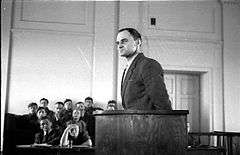

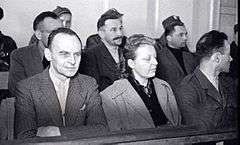
Pilecki was arrested by agents of the Ministry of Public Security on 8 May 1947,[14] and he was repeatedly tortured before going to trial. The investigation of his activities was supervised by Colonel Roman Romkowski. He was interrogated by Col. Józef Różański and lieutenants S. Łyszkowski, W. Krawczyński, J. Kroszel, T. Słowianek, Eugeniusz Chimczak, and S. Alaborski—men who were infamous for their savagery. But Pilecki sought to protect other prisoners and revealed no sensitive information.[14]
A show trial took place on 3 March 1948,[30] and testimony against Pilecki was presented by future Polish prime minister Józef Cyrankiewicz, himself an Auschwitz survivor. Pilecki was charged with illegal border crossing, use of forged documents, not enlisting with the military, carrying illegal arms, espionage for General Władysław Anders, espionage for "foreign imperialism" (British intelligence),[7] and planning to assassinate several officials of the Ministry of Public Security of Poland. Pilecki denied the assassination charges, as well as espionage, although he admitted to passing information to the 2nd Polish Corps, of which he considered himself an officer and thus claimed that he was not breaking any laws. He pleaded guilty to the other charges. He was sentenced to death on 15 May with three of his comrades, and he was executed with a shot to the back of the head at the Mokotów Prison in Warsaw on 25 May 1948[8] by Staff Sergeant Piotr Śmietański (who was nicknamed "The Butcher of Mokotow Prison" by the inmates).[31]
I've been trying to live my life so that in the hour of my death I would rather feel joy, than fear.
— Pilecki after the announcement of the death sentence, Bartłomiej Kuraś, Witold Pilecki – w Auschwitzu z własnej woli, "Ale Historia", in Gazeta Wyborcza, 22 April 2013.
Pilecki's place of burial has never been found but is thought to be somewhere within Warsaw's Powązki Cemetery.[14][32] After the fall of Communism in Poland, a symbolic gravestone was erected in his memory at Ostrowa Mazowiecka Cemetery. In 2012, Powązki Cemetery was partially excavated in an effort to find his remains.[33]
Legacy
Pilecki's show trial and execution was part of a wider campaign of repression against former Home Army members and others connected with the Polish government in exile in London. In 2003, prosecutor Czesław Łapiński and several others involved in the trial were charged with complicity in Pilecki's murder. Chief prosecution witness Józef Cyrankiewicz was already dead, and Łapiński died in 2004 before the trial was concluded.[15]
_(19122651385).jpg)
Pilecki and all others sentenced in the show trial were rehabilitated on 1 October 1990.[15] He was awarded the Order of Polonia Restituta in 1995, and he received the Order of the White Eagle in 2006, the highest Polish decoration.[14][32] On 6 September 2013, he was promoted to Colonel by the Minister of National Defence.[34]
Films about Pilecki include Śmierć rotmistrza Pileckiego (The Death of Captain Pilecki, 2016) starring Marek Probosz,[35] Pilecki (2015) starring Mateusz Bieryt,[36] and the documentaries Against the Odds: Resistance in Nazi Concentration Camps (2004)[37] and Heroes of War: Poland (2014) produced by Sky Vision for the History Channel UK.[38] A number of books have been written about him, and his comprehensive 1945 report on his undercover mission at Auschwitz was published in English in 2012 under the title The Auschwitz Volunteer: Beyond Bravery.[39] The New York Times called it "a historical document of the greatest importance".[5]
Polish Army career summary
- Ensign (chorąży) from July 1925
- Second Lieutenant (podporucznik) from 1926
- First Lieutenant (porucznik) from 1941 (promoted while at Auschwitz)
- Captain (rotmistrz) from 23 February 1944 (with seniority from 1943)[14]
- Colonel (pułkownik) from 6 September 2013 (posthumously).[34]
See also
- 1951 Mokotów Prison execution
- Anti-communist resistance in Poland (1944–46)
- Łukasz Ciepliński
- Emil August Fieldorf
- Heroes (Sabaton album), where the song "Inmate 4859" tells Captain Pilecki's story
- History of Poland (1939–45)
- Jan Karski
- Polish contribution to World War II
- Rescue of Jews by Poles during the Holocaust
- Soviet repressions of Polish citizens (1939–46)
- Vrba-Wetzler report
- Western betrayal
References
- ↑ Marco Patricelli, Il volontario, Laterza, Roma 2010, ISBN 9788842091882
- ↑ M. Patricelli, cit., pp.53-180.
- ↑ M. Patricelli, cit., pp. 181-202.
- ↑ For a detailed history of the Warsaw uprising and the role of Witold Pilecki (known as "Captain Roman"), see Norman Davies, Rising '44. "The Battle for Warsaw" (London: Pan Books, 2004).
- 1 2 3 Snyder, Timothy (22 June 2012) Were We All People?, The New York Times.
- ↑ M. Patricelli, cit., pp. 247-268.
- 1 2 3 4 Tchorek 2009
- 1 2 Piekarski 1990, p. 249
- ↑ Remembering Unsung Heroes Of The Holocaust, The Jewish Week. Published on 1 February 2013.
- 1 2 Auschwitz inmate Pilecki – 'diamond among heroes', Thenews.pl (Polish Radio English Section). Published on 28 January 2013.
- ↑ The Auschwitz volunteer: about the book, Aquila Polonica Publishing, Los Angeles.
- 1 2 The Book Heaven, The man who volunteered for Auschwitz: the greatest story never told, Stanford University. Posted 10 June 2012.
- ↑ Captain Witold Pilecki commemorated at the U.S. Holocaust Memorial Museum in Washington, DC, Embassy of the Republic of Poland in Washington, DC.
- 1 2 3 4 5 6 7 8 9 10 11 12 13 14 15 16 17 18 19 20 21 22 23 24 25 26 27 28 29 30 31 32 33 34 35 36 37 38 39 40 Świerczek, Lidia. Pilecki's life. Institute of National Remembrance. Last accessed on 14 March 2009.
- 1 2 3 4 5 (in Polish) "Detailed biography of Witold Pilecki on Whatfor". Archived from the original on 16 May 2007. Retrieved 21 November 2007.
- ↑ Beadle, Jeremy and Harrison, Ian (2008) Firsts, lasts & onlys: military. Anova Books. ISBN 1-905798-06-7. p. 129
- ↑ Wysocki, Wiesław Jan (1994) Rotmistrz Pilecki. "Gryf". ISBN 83-85521-23-2. p. 32
- 1 2 Lewis 1999, p. 389
- ↑ Lukas, Richard C. (1989) Out of the inferno: Poles remember the Holocaust. University Press of Kentucky. ISBN 0-8131-1692-9. p. 5
- 1 2 3 Lewis 1999, p. 390
- 1 2 Pilecki, Witold (2012). The Auschwitz Volunteer: Beyond Bravery. USA: Aquila Polonica (US) Ltd. p. 460. ISBN 978-1-60772-010-2.
- 1 2 3 4 Wyman 1976, p. 1168
- 1 2 3 4 Foot 2003, pp. 117–126
- ↑ Lewis 1999, p. 393
- ↑ Lewis 1999, p. 394
- ↑ Garlinski, Jozef (1975) Fighting Auschwitz: the Resistance Movement in the Concentration Camp. Fawcett. ISBN 0-904014-09-6. pp. 191–197
- ↑ Lewis 1999, p. 399
- ↑ "Raport"W"". polandpolska.org. Retrieved 2 February 2016.
- ↑ Wyman 1976, p. 1169
- ↑ The Times, 1948
- ↑ Płużański, Tadeusz M. "Strzał w tył głowy." Publicystyka Antysocjalistycznego Mazowsza.
- 1 2 (in Polish) "60 lat temu zginął rotmistrz Witold Pilecki" (Sixty years ago Captain Witold Pilecki died) Gazeta Wyborcza, PAP, 23 May 2008.
- ↑ Puhl, Jan. (9 August 2012) Poland Searches for Remains of World War II Hero Witold Pilecki. Spiegel.de. Retrieved on 19 September 2015.
- 1 2 "MON awansował Witolda Pileckiego" (in Polish). RMF FM/PAP. 6 September 2013. Retrieved 10 October 2013.
- ↑ Śmierć Rotmistrza Pileckiego. FilmPolski.pl. Retrieved on 19 September 2015.
- ↑ "Pilecki (2015)". IMDb.
- ↑ Against The Odds, Capitaljfilms.com. Retrieved 19 September 2015.
- ↑ History UK orders "Heroes of War" from Sky Vision. Realscreen (25 April 2013). Retrieved 19 September 2015.
- ↑ Pilecki, Witold (30 April 2015). The Auschwitz Volunteer: Beyond Bravery. Translated by Garlinski, Jarek. Aquila Polonica. ISBN 1-60772-009-4.
Bibliography
- Foot, Michael Richard Daniell (2003), "Witold Pilecki", Six Faces of Courage: Secret agents against Nazi tyranny, Leo Cooper, ISBN 0-413-39430-1
- Davies, Norman, Rising '44: "The Battle for Warsaw" (London: Pan Books, 2004), ISBN 0-333-90568-7 .
- Lewis, Jon E. (1999), The Mammoth Book of True War Stories, Carroll & Graf Publishers, ISBN 0-7867-0629-5
- Piekarski, Konstanty R. (1990), Escaping Hell: The Story of a Polish Underground Officer in Auschwitz and Buchenwald, Dundurn Press Ltd., ISBN 1-55002-071-4
- Staff correspondent (5 March 1948), "Polish Left-Wing Relations: No Fusion as Yet", The Times, London, p. 3, retrieved 12 March 2009
- Tchorek, Kamil (12 March 2009), "Double life of Witold Pilecki, the Auschwitz volunteer who uncovered Holocaust secrets", The Times, London, retrieved 16 March 2009
- Wyman, David S. (December 1976), "Review: Jozef Garlinski. Fighting Auschwitz: The Resistance Movement in the Concentration Camp", American Historical Review, American Historical Association, 81 (5), pp. 1168–1169, doi:10.2307/1853043, ISSN 0002-8762, JSTOR 1853043
Further reading
- Ciesielski E. Wspomnienia Oświęcimskie [Auschwitz Memoirs]. Kraków: 1968.
- Cyra, Adam. Ochotnik do Auschwitz – Witold Pilecki 1901–1948 [Volunteer for Auschwitz]. Oświęcim: 2000. ISBN 83-912000-3-5
- Cyra, Adam. Spadochroniarz Urban [Urban Paratrooper]. Oświęcim: 2005.
- Cyra, Adam and Wiesław Jan Wysocki. Rotmistrz Witold Pilecki. Oficyna Wydawnicza VOLUMEN, 1997. ISBN 83-86857-27-7
- Garlinski, Jozef. Fighting Auschwitz: the Resistance Movement in the Concentration Camp. Fawcett, 1975. ISBN 0-449-22599-2 reprinted by Time Life Education, 1993. ISBN 0-8094-8925-2 (see also review in The Times)
- Gawron, W. Ochotnik do Oświęcimia [Volunteer for Auschwitz]. Calvarianum: Auschwitz Museum, 1992.
- Patricelli, M. Il volontario [The Volunteer]. Laterza 2010. ISBN 88-420-9188-X
- Piekarski, Kon. Escaping Hell: The Story of a Polish Underground Officer in Auschwitz and Buchenwald. Dundurn Press, 1989. ISBN 1-55002-071-4, ISBN 978-1-55002-071-7
- Pilecki, W. (Translated by Jarek Garlinski) The Auschwitz Volunteer: Beyond Bravery. Aquila Polonica, 2012. ISBN 978-1-60772-010-2, ISBN 978-1-60772-009-6
- Wysocki, Wiesław Jan. Rotmistrz Pilecki. Pomost, 1994. ISBN 83-85209-42-5
External links
| Wikiquote has quotations related to: Witold Pilecki |
- Tablet Magazine essay Vladislav Davidzon
- Meet The Man Who Sneaked Into Auschwitz.
- The Man Who Volunteered for Auschwitz
- Witold Pilecki's report from Auschwitz in English
- Witold Pilecki's report from Auschwitz in Polish (in Polish)
- Additional reports of Pilecki (in Polish)
- Andrzej M. Kobos, Witold Pilecki w Piekle XX Wieku, Zwoje 5 (9), 1998 (in Polish)
- Józef Garlinski, The Polish Underground Movement in Auschwitz Concentration Camp
- The Murder of Cavalry Captain Witold Pilecki
- Operation Auschwitz on IMDb